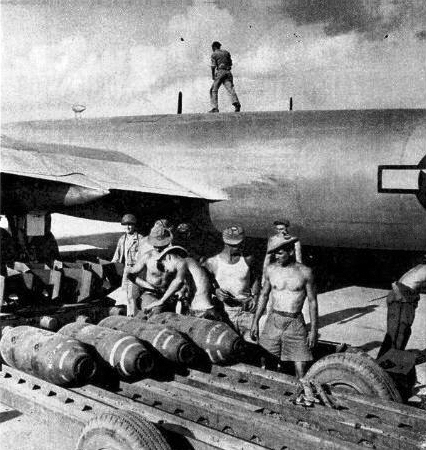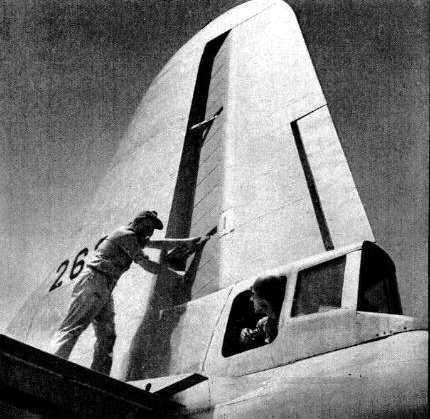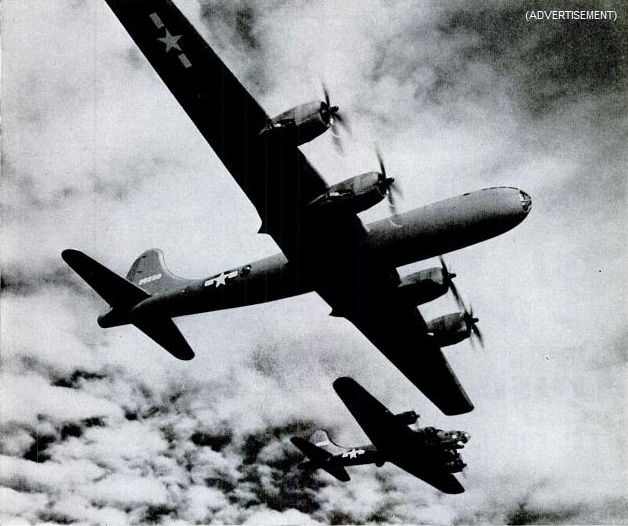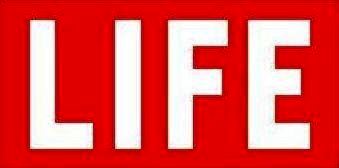

|
On June 16 (Tokyo time) the U.S. Army Air Forces began to use a weapon which it had long threatened Japan. Employing the most powerful bomber in the world, the Boeing B-29, it started the strategic bombing of the Japanese homeland. Unveiling its long-secret giant of the skies, in the works since 1936, the Army revealed that this Superfortress can fly faster and higher than the famous Flying Fortress (B-17) with a much heavier bomb load, shoot at attacking planes from remotely controlled turrets. On its first mission its performance was highly satisfactory. Hampered by the necessity of flying all bombs and fuel over the "Hump" from India to China, the first raid was but a token of what will surely come. For with the lessons learned in Europe, where strategic bombing has had to relinquish its priority to tactical bombing since the invasion, U.S. fliers are eager to prove with their new weapon that an enemy country can be crippled and killed by attacks from the air. The first blow hit the Japanese where it hurt most. As these pictures by LIFE Photographer Bernard Hoffman show, the behemoths took off from bases in China which had been hand-built by 360,000 coolies in a few months. They flew to the southernmost island of Japan, Kyushu. There they cascaded high explosives on Yawata, the Far East's Pittsburgh, which produces a fifth of all Japan's steel. One plane was lost in the intense anti-aircraft fire over the target and three others failed to return from the raid. As they headed back toward China, crews could see fires rising into the night sky, visible for more than 60 miles. Japanese spokesmen belittled the damage done but an extraordinary session of the war cabinet obviously considered the attack with more gravity.
Now all Japan, in whose small land area industry is crowded together, lies open to aerial attack.
Her coastal fleet, released to haul booty from conquered lands, will probably have to be recalled to help the over-burdened railway system which can be smashed at key points.
|

|

MEN TURN PROPELLERS BEFORE B-29's MOTORS ARE STARTED HOFFMAN FLEW IN THIS PLANE |

PLANES ARE BOMBED UP BEFORE RAID ALL OF THEM GOT BACK WITH SPARE GAS |

CREWMAN LEANS OUT OF EXTENDED B-29 NOSE DISTINGUISHED FEATURE OF THE NEW PLANE |

TAIL GUNNER GETS READY FOR THE TAKE-OFF HE HAS MORE ROOM THAN IN B-17 |

|
| B-29 at Chinese base revs huge 16-ft. propellers preparatory to take-off. It is unit of the new Twentieth Air Force, headquartered in Washington, which will range all over the world. Commanding officer of 20th Bomber Command in CBI Theater is Brig. General Kenneth B. Wolfe. |
 More correspondents than had ever before gone along on a major bombing mission flew over Japan with the B-29"s.
Eleven newsmen, including three photographers, made the trip.
Only 10 came back, for William Shenkel* of Newsweek was in one of the planes listed as missing after the attack.
The others' press and radio reports gave a graphic account of the new plane's performance and the devastation spread in one of the largest industrial areas of Japan.
More correspondents than had ever before gone along on a major bombing mission flew over Japan with the B-29"s.
Eleven newsmen, including three photographers, made the trip.
Only 10 came back, for William Shenkel* of Newsweek was in one of the planes listed as missing after the attack.
The others' press and radio reports gave a graphic account of the new plane's performance and the devastation spread in one of the largest industrial areas of Japan.
Harry Zinder, a Time and LIFE correspondent who was a passenger in one of the three B-29s forced down before returning to its base, cabled his impressions of the raid: "We were airborne from the 20th Bomber Command's forward base about an hour before dusk, and when the darkness closed in and made our job more ominous we had crossed the narrow safe corridor through free China into occupied China. At last we pushed across the coast into the sea. There was a soft quiet then as the ship plowed through the night air toward the junction of the East China and Yellow Seas toward Yawata on the Japanese mainland. A gunner suddenly shouted through the intercom: 'There's a B-29 on our left,' and as if that were a signal others throughout the plane too found Superfortresses above, below and around us. The battle fleet was moving in great strength. "Ahead of us we saw distant flares of ack-ack and the spatulate fingers of searchlights anxiously feeling for other planes over the target. Then the shipped was bathed in brilliant white light, making it look like a ghost plane. The pilot nosed the ship down slightly when the bombardier hit the bomb release that sent many thousands of pounds of bombs on the Imperial Iron and Steel Works. The plane spurted through the air in even, powerful flight as we headed back for China. "As morning came, our No. 3 engine coughed out and the pilot decided to land rather than try getting through the wall of treacherous mountain peaks ahead. He brought it down just within our lines in a green field by the side of a river and Chinese troops ran up to question us. An officer promised in an amazingly offhand way to furnish 1,500 gallons of high-octane gas, provide some tools and level a strip for a take-off. But after checking the B-29 the crew relunctantly admitted it was beyond repair and prepared to destroy it. Then we heard the buzz of two Japanese fighters. They peeled off and spattered bullets across the wings and through the fuselage and kicked up little spurts of grass and mud along the ditch in which we lay. Nine Japanese fighters and siz bombers next appeared overhead and when the fighters were through strafing, the bombers came in leisurely as though it were target practice. They couldn't have wanted a better target: a clear day, disabled plane and no opposition. They must have known this was one of the bombers that raided their homeland and they were determined to kill anything in it or around it. "By midmorning the B-29 was a brokenm blazing wreck.
High columns of black smoke poured out of her and at last the Japanese planes went.
Before we left, our pilot looked at the ship and came slowly back cursing.
'Those goddamn bastards,' he said, 'they'll pay for it. They'll pay for it.'"
|
|
|

|

CLICK TO VIEW COMPLETE ADVERTISEMENT

LIFE'S COVER: Admiral Chester W. Nimitz presides over the greatest fleet in the history of ocean warfare. Arriving in Pearl Harbor while smoke still rose from the holocaust of December 7, 1941, he has served uninterruptedly since as Commander in Chief of the Pacific Fleet and the Pacific Ocean Area. Every great naval battle from Midway to Saipan has been fought under him as CINCPAC (Commander-In-Chief Pacific).


Adapted by Carl W. Weidenburner
from the July 10, 1944 issue of LIFE.
Portions copyright 1944 Time, Inc.
FOR PRIVATE NON-COMMERCIAL HISTORICAL REFERENCE ONLY
TOP OF PAGE ABOUT THIS PAGE
MORE PHOTOS OF "OLD-BITCH-U-AIRY BESS"
MORE CBI FROM LIFE MAGAZINE CLOSE THIS WINDOW
VISITS



